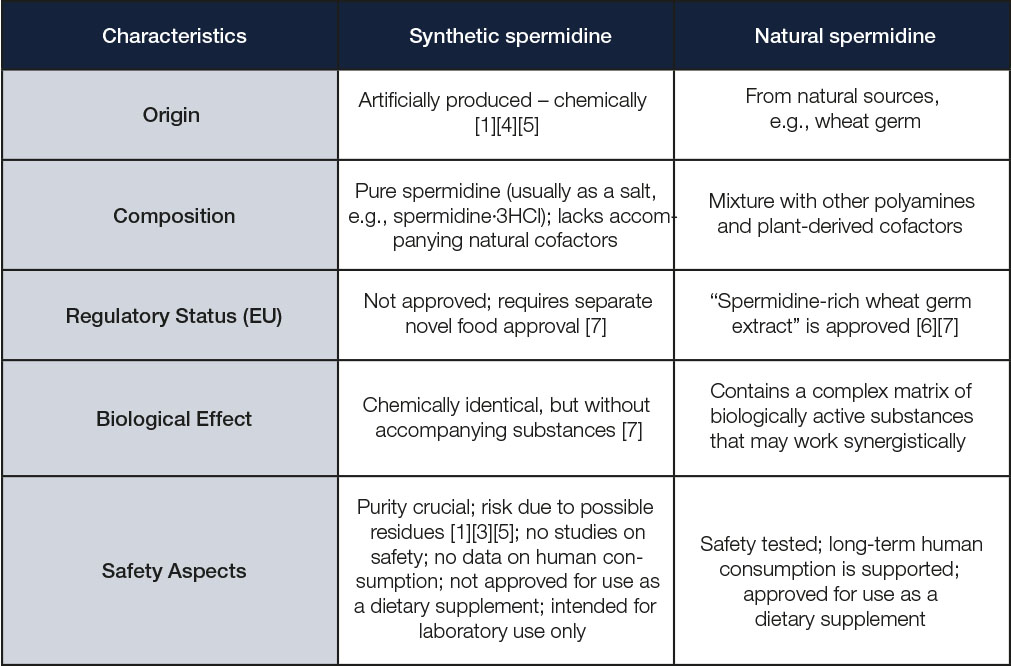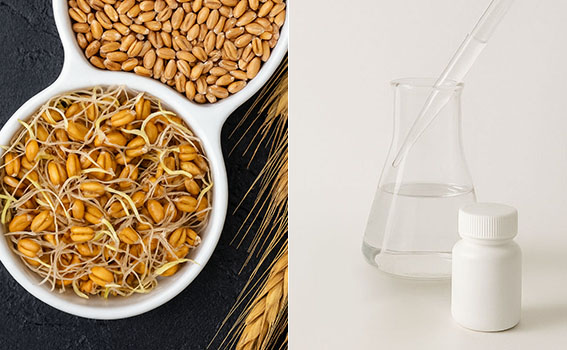The use of synthetic spermidine in dietary supplements is steadily increasing, but how safe is it? This report examines the manufacturing processes and regulatory requirements in the EU, as well as the differences between synthetic and natural spermidine.
Synthetic Spermidine
Manufacturing, Composition, and Health Effects
What is synthetic spermidine?
Synthetisches Spermidin ist die künstlich hergestellte Form des natürlichen Stoffes Spermidin, der in fast allen Lebewesen vorkommt, darunter Bakterien, Pilze, Pflanzen, Tiere und Menschen.
Unlike naturally occurring spermidine, synthetic spermidine is produced industrially or in the laboratory from fossil fuel–derived precursors. It is typically obtained as a salt, most commonly spermidine trihydrochloride (spermidine·3HCl). 5
A key difference between natural and synthetic spermidine is their source and production method. In natural sources such as wheat germ, spermidine occurs together with other biogenic amines such as spermine and putrescine, as well as cofactors like vitamins, minerals, and amino acids. This natural combination helps maintain a balanced polyamine ratio in the body, which supports optimal cellular function. By contrast, synthetic products often contain only one polyamine at unnaturally high concentration compared to the other polyamines. This disrupts the natural balance. Additionally, natural spermidine comes from a non-GMO, sustainable source — often using wheat germ, a nutrient-rich byproduct — which enhances transparency, regulatory ease, and consumer trust compared to lab-produced alternatives.
How is it manufactured?
spermidine·3HCl [1][2]. Some of the chemicals used in this process are strong, and acrylonitrile is considered toxic and possibly carcinogenic (IARC Group 2B) [1][3]. Even though chemically synthesized spermidine·3HCl is purified before use, trace residues of the hazardous chemicals used in its production can potentially remain. This is why natural spermidine from wheat germ or other plant sources is often considered a safer and cleaner alternative.
What are the risks associated with taking synthetic spermidine?
However, the following applies:
- Purity is crucial—residues of acrylonitrile, solvents, or heavy metals pose a risk [5].
- There is little data available on long-term use, so the effects over a longer period of time have not been sufficiently researched.
- An overdose can lead to gastrointestinal complaints, which is why the EU has set a limit of 6 mg/day and a maximum concentration of 2.4 mg/g [6].
Approval in the EU
In contrast, synthetic spermidine salts (e.g., spermidine·3HCl) are not yet approved and may not be used in foods or supplements without their own novel food approval [7]. This regulatory gap underscores the importance of choosing natural, approved sources for supplementation.
Comparison of synthetic vs. natural spermidine

Conclusion
To date, there are no meaningful studies on the health effects of synthetically produced spermidine on humans, and there is no synthetic spermidine that is approved for human use. In summary, while synthetic spermidine is useful for laboratory research, natural spermidine from approved plant sources remains the safer and better-characterized option for human supplementation, providing both efficacy and regulatory compliance.
Sources:
[1] US20230219881A1 – Synthesis of Spermidine, Spermine, and Free Bases Thereof – Google Patents (https://patents.google.com/patent/US20230219881A1/en)
[2] Application and Synthesis of spermidine_Chemicalbook (https://www.chemicalbook.com/article/application-and-synthesis-of-spermidine.htm)
[3] [PDF] Acrylonitrile – Environmental Protection Agency (EPA) (https://www.epa.gov/sites/default/files/2016-09/documents/acrylonitrile.pdf)
[4] Application for the Approval of Spermidine-3HCl Produced by Genetically Engineered Saccharomyces cerevisiae CHRYSPD3 for Use as an Ingredient in Conventional Foods, Foods for Total Diet Replacement and Weight Control and Food Supplement Products Pursuant to Regulation (EU) 2015/2283
(https://food.ec.europa.eu/document/download/9635ba18-7d3c-481b-b32f-b0a20f8c3ea4_en?filename=novel-food_sum_ongoing-app_2024-28790.pdf)
[5] A toxicological assessment of spermidine trihydrochloride produced using an engineered strain of Saccharomyces cerevisiae – PubMed (https://pubmed.ncbi.nlm.nih.gov/38163454/)
[6] EUR-Lex – 02017R2470-20250220 – EN – EUR-Lex (https://eur-lex.europa.eu/eli/reg_impl/2017/2470/2025-02-20/eng)
[7] Spermidin weltweit: Regulierung und Verfügbarkeit im globalen Überblick (https://www.nordicoil.de/blogs/nahrungsergaenzungsmittel/spermidin-regulierung-verfuegbarkeit-weltweit?srsltid=AfmBOoq-VtFpIple640Oo9h7b8bTuvDJbeniynyDFEV1tj7bCi608dxh)
2025_
